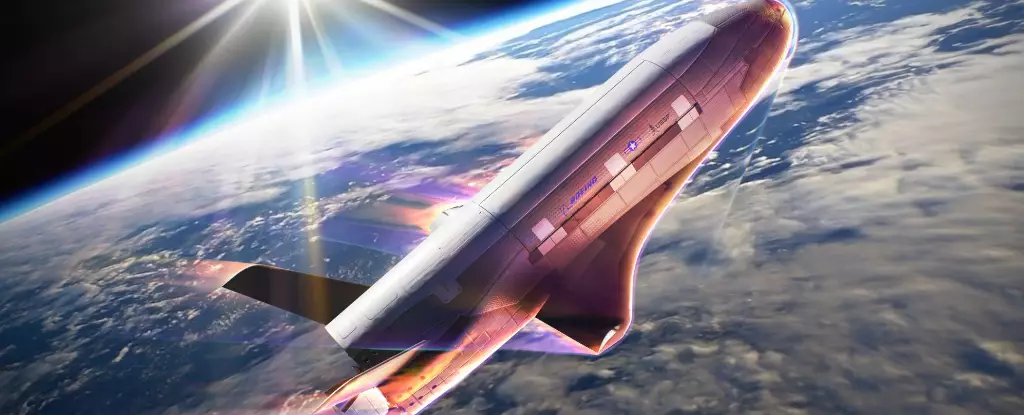

The X-37B Orbital Test Vehicle (OTV) has become a centerpiece of intrigue since it made its inaugural flight in 2011. Crafted by Boeing and managed by the United States Space Force (USSF), this stealthy, reusable spacecraft operates in Low-Earth Orbit (LEO) between 240 and 800 kilometers (approximately 150 to 500 miles) above the planet. As of December 29, 2023, the X-37B commenced its seventh mission, designated OTV-7, igniting renewed interest in its capabilities and the nature of its objectives.
With the backdrop of an advanced technological landscape, the OTV-7 mission is reportedly focused on a range of experimental activities, including the investigation of space radiation and the evaluation of Space Domain Awareness (SDA) technologies. Among the fascinating techniques being employed, the X-37B will soon undertake a series of orbital changes using a method known as “aerobraking,” which involves dipping into the upper atmosphere to shed speed and adjust its orbit—a move designed not only for efficiency but also for strategic stealth.
This maneuver marks a significant shift in the operational capabilities of the vehicle, paving the way for low-pass operations undetected by terrestrial observers or adversaries. By leveraging past experiences from previous missions—both terrestrial and extraterrestrial—the X-37B aims to enhance its effectiveness in challenging environments.
Historically, aerobraking has been a game-changing maneuver for various spacecraft. The Mars Global Surveyor (MGS) employed its solar panels as wings to manage its descent through Mars’ delicate upper atmosphere in 1997, leading to a successful reduction in its orbital altitude. The technique was notably replicated by other missions, including the Mars Odyssey and the Mars Reconnaissance Orbiter. Such experiences illustrate the deep well of knowledge available to engineers at the USSF as they optimize the X-37B’s functions.
A key aspect of the X-37B’s current mission involves not just the execution of complex maneuvers but also the integration of lessons learned throughout decades of space exploration. The melding of historical data with modern engineering symbolizes a growing sophistication within the military space sector, reinforcing its commitment to innovation.
One of the most compelling attributes of the X-37B is its capacity for stealth. Discussions surrounding its ability to execute unpredictable orbital paths suggest that it can elude detection and prevent adversarial tracking, leaving competitors puzzled. As former U.S. Air Force Secretary Heather Wilson pointed out, the X-37B’s capacity for orbital maneuverability drives competitors to expend resources in trying to monitor and predict its movements.
The intentional vagueness surrounding the spacecraft’s mission parameters exemplifies a strategic advantage; military assets operating under a veil of secrecy can facilitate national security initiatives without giving away critical operational insights. This element of unpredictability serves as a psychological and tactical tool in a realm where awareness is power—a principle that resonates deeply within military applications of space technology.
Once the aerobraking operations conclude, the X-37B will embark on a variety of additional tests and studies. In alignment with its mission goals, the vehicle is equipped to explore new orbital regimes and assess advanced SDA technologies. Among the science experiments onboard is NASA’s “Seeds-2” project, which seeks to examine the effects of space radiation on plant seeds and provide foundational research for future agricultural endeavors in extraterrestrial environments.
As part of its commitment to responsible space operations, the X-37B is also set to release some service module components in accordance with established standards for space debris mitigation. This measure underscores the increasing emphasis on sustainability in space exploration—a growing concern as humanity expands its footprint beyond Earth.
The X-37B stands as a testament to the United States’ ongoing pursuit of leadership in space technology. Its combination of innovative capabilities and strategic stealth positions it as a critical asset in shaping the future of military space operations. With each mission, especially the current OTV-7 endeavor, it contributes not only to national security interests but also to the broader question of how mankind will navigate and utilize space moving forward. As the boundaries of exploration continue to expand, the X-37B serves as a symbol of both the wonders and the complexities lying just beyond our atmosphere.
Rogue waves have long been a subject of fascination and terror in maritime lore. These…
As the world grapples with public health challenges, especially those posed by infectious diseases, the…
The Sombrero Galaxy, also known as Messier 104, embodies a breathtaking blend of spirals and…
In recent advances in quantum electronics, a groundbreaking discovery leveraging the concept of kink states…
In the intricate tapestry of nature, ice often exists in a delicate balance with liquid…
In an astonishing event that captured global attention, a rogue object from beyond our Solar…
This website uses cookies.